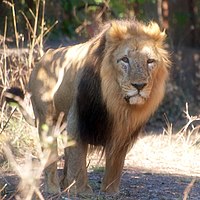
Photo from wikipedia
Asiatic black bears (Ursus thibetanus) have a widespread distribution in mountain landscapes, and are considered vulnerable globally, but are low-priority species for conservation in Nepal. Habitat fragmentation, illegal hunting, and… Click to show full abstract
Asiatic black bears (Ursus thibetanus) have a widespread distribution in mountain landscapes, and are considered vulnerable globally, but are low-priority species for conservation in Nepal. Habitat fragmentation, illegal hunting, and human-bear conflict are the major threats to Asiatic black bears across their global range. Having an adequate level of genetic variation in a population helps with adapting to rapidly changing environments, and thus is important for the long-term health of bear populations. Accordingly, we conducted non-invasive surveys of bear populations in the Annapurna Conservation Area (ACA) to elucidate genetic diversity, genetic structure, and the phylogenetic relationship of Asiatic black bears from this region of Nepal to other subspecies. To assess levels of genetic diversity and population genetic structure, we genotyped eight microsatellite loci using 147 samples, identifying 60 individuals in an area of approximately 525 km2. We found that the Asiatic black bear population in the ACA has maintained high levels of genetic diversity (HE = 0.76) as compared to other bear populations from range countries. We did not detect a signature of population substructure among sampling localities and this suggests that animals are moving freely across the landscape within the ACA. We also detected a moderate population size that may increase with the availability of suitable habitat in the ACA, so bear-related conflict should be addressed to ensure the long-term viability of this expanding bear populations. Primers specific to bears were designed to amplify a 675 bp fragment of the mitochondrial control region from the collected samples. Three haplotypes were observed from the entire conservation area. The complete mitochondrial genome (16,771 bp), the first obtained from wild populations of the Himalayan black bear (U. t. laniger), was also sequenced to resolve the phylogenetic relationships of closely related subspecies of Asiatic black bears. The resulting phylogeny indicated that Himalayan black bear populations in Nepal are evolutionary distinct from other known subspecies of Asiatic black bears.
Journal Title: PLoS ONE
Year Published: 2018
Link to full text (if available)
Share on Social Media: Sign Up to like & get
recommendations!